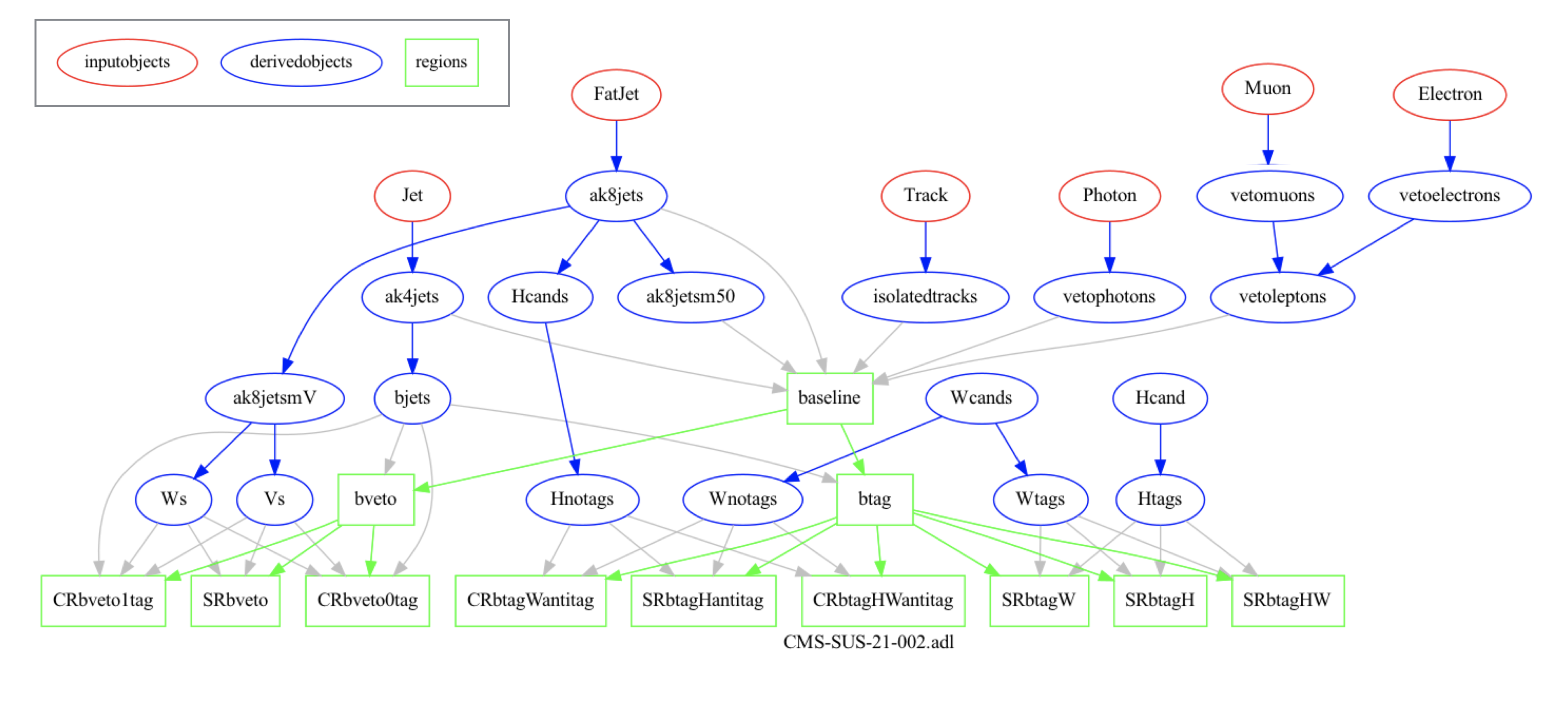Introduction
Overview
Teaching: 15 min
Exercises: 0 minQuestions
What is ADL?
What is CutLang?
Why would we use ADL/CutLang to write and perform analyses?
Objectives
Understand the concept of ADL and its main principles.
Understand the distinction between using ADL and using a general purpose language for writing analyses.
Understand the concept of runtime interpreter.
What is ADL?
(More information on cern.ch/adl)
LHC data analyses are usually performed using complex analysis frameworks written in general purpose languages like C++ and, more recently, Python. This method is very flexible, and usually is easy for simple analyses with simple selections. But what if we had a really complex analysis with very complex object and event selections. For example, take a look at the graph below, which describes a CMS search for supersymmetry (arXiv:2205.09597):

This analysis works with several different types of objects and multiple event selection regions, some of which are dependent on each other. When we write such an analysis with a general purpose language, it becomes increasingly harder to visualize and keep track of the physics algorithm details. As the analysis physics content becomes more intricate, analysis code will become more complex, and harder to follow.
The main reason behind this is that, when we write code using general purpose languages, we intertwine the physics algorithm with other technical details, e.g. accessing files, accessing variables, importing modules, etc. Despite the flexibility, all such technicalities obscure the code.
However there is another emerging alternative which allows to decouple physics algorithm from the technical code and write analyses with a simple, self-describing syntax. Analysis Description Language (ADL) is a HEP-specific analysis language developed with this purpose. Its main aim is to describe analyses in a more intuitive and physics-focused way.
More formally, ADL is a declarative domain specific language (DSL) that describes the physics content of a HEP analysis in a standard and unambiguous way.
- External DSL: Custom-designed syntax to express analysis-specific concepts. Reflects conceptual reasoning of particle physicists. Focus on physics, not on programming.
- Declarative: Tells what to do, but not how to do it.
- Human readable: Clear, self-describing syntax rules.
- Designed for everyone: experimentalists, phenomenologists, students, interested public…
ADL is designed to be framework-independent. Any framework recognizing ADL can perform tasks with it. Physics information becomes independent from software and framework details. This allows:
- Multi-purpose use of analysis description: Can be automatically translated or incorporated into the GPL / framework most suitable for a given purpose, e.g. exp, analysis, (re)interpretation, analysis queries, …
- Efficient communication between groups: experimentalists, phenomenologists, referees, students, public, …
- Accessible preservation of analysis physics logic.
ADL mainly focuses on describing event processing. This includes object selections, event variable definitions and event selections. It can also described histogramming, and partially systematic uncertainties.
ADL consists of blocks separating object, variable and event selection definitions for a clear separation of analysis components. Blocks have a keyword-expression structure. Keywords specify analysis concepts and operations. Syntax includes mathematical and logical operations, comparison and optimization operators, reducers, 4-vector algebra and HEP-specific functions (dphi, dR, etc.).
ADL is designed with the goal to be self-describing, so especially for simple cases, one does not need to read syntax rules to understand an ADL description. However if you are interested, the set of syntax rules can be found here.
ADL is a standard, which allows all analyses to be described in the same way. Having access to many analyses written in the same way can help us understand them easier, learn their physics logic easily, and use them in our own studies.
What is CutLang?
Once an analysis is written it needs to be run on events. This is achieved by CutLang , the runtime interpreter that reads and understands the ADL syntax and runs it on events. A runtime interpreter does not require to be compiled. The user only modifies the ADL description, and runs CutLang. CutLang is also a framework which automatically handles many tedious tasks as reading input events, writing output histograms, etc. CutLang can be run on various environments such as linux, mac, conda, docker, jupyter, etc.
In case you are interested to learn more on CutLang, please see the CutLang github and references in the cern.ch/adl) portal.
Key Points
ADL is a declarative domain specific language (DSL) that describes the physics content of a HEP analysis in a standard and unambiguous way.
ADL’s purpose is to decouple the physics logic of analyses from technical operations, and make the physics logic more accessible.
CutLang is a runtime interpreter that reads and understands the ADL syntax and runs it on events.